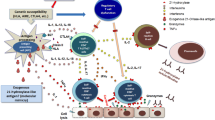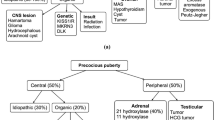Abstract
Context
Regional variation in prevalence of genetic mutations in growth hormone deficiency (GHD) is known.
Aim
Study phenotype and prevalence of mutations in GH1, GHRHR, POU1F1, PROP1 genes in GHD cohort.
Methods
One hundred and two patients {Isolated GHD (IGHD): 79; combined pituitary hormone deficiency (CPHD): 23} with orthotopic posterior pituitary were included. Auxologic, hormonal and radiological details were studied. All four genes were analysed in IGHD patients. POU1F1 and PROP1 were studied in CPHD patients.
Results
Of 102, 19.6% were familial cases. Height SDS, mean (SD) was − 5.14 (1.63). Peak GH, median (range) was 0.47 ng/ml (0–6.59), 72.5% patients had anterior pituitary hypoplasia (APH). Twenty mutations (novel: 11) were found in 43.1% patients (n = 44, IGHD-36, CPHD-8). GHRHR mutations (n = 32, p.Glu72* = 24) were more common than GH1 mutations (n = 4) in IGHD cohort. POU1F1 mutations (n = 6) were more common than PROP1 mutations (n = 2) in CPHD cohort. With few exceptions, this prevalence pattern is contrary to most studies in world-literature. No patients with peak GH > 4 ng/ml had mutations, signifying it as negative predictor. While many parameters were significant on univariate analysis, only positive family history and lower median peak GH levels were significant predictors of mutations on multivariate analysis in IGHD patients.
Conclusion
At variance with world literature, we found reverse predominance of GHRHR over GH1 mutations, POU1F1 over PROP1 mutations and predominance of GHRHR p.Glu72* mutations thus re-affirming the regional diversity in GHD genetics. We report positive and negative predictors of mutations in GHD.
Similar content being viewed by others
Abbreviations
- GHD:
-
Growth hormone deficiency
- IGHD:
-
Isolated growth hormone deficiency
- CPHD:
-
Combined pituitary hormone deficiency
- GH1:
-
Growth hormone 1
- GHRHR:
-
Growth hormone releasing hormone receptor
- PROP1:
-
PROP paired-like homeobox 1
- POU1F1:
-
POU class 1 homeobox 1
- EPP:
-
Ectopic posterior pituitary
- PSIS:
-
Pituitary stalk interruption syndrome
- IGF-1:
-
Insulin like growth factor 1
- SDS:
-
Standard deviation score
- GH:
-
Growth hormone
- TSH:
-
Thyroid stimulating hormone
- FSH:
-
Follicle stimulating hormone
- LH:
-
Luteinizing hormone
- ACTH:
-
Adrenocorticotropic hormone
- TRH:
-
Thyrotropin releasing hormone
- BLAST:
-
Basic local alignment search tool
- ExAC:
-
Exome aggregation consortium
- APH:
-
Anterior pituitary hypoplasia
References
Giordano M (2016) Genetic causes of isolated and combined pituitary hormone deficiency. Best Pract Res Clin Endocrinol Metab 30(6):679–691
Alatzoglou KS, Dattani MT (2010) Genetic causes and treatment of isolated growth hormone deficiency – an update. Nat Rev Endocrinol 6:562–576
Fang Q, George AS, Brinkmeier ML et al (2016) Genetics of combined pituitary hormone deficiency: roadmap into the genome era. Endocr Rev 6:636–675
Madeira J, Nishi M, Nakaguma M et al (2017) Molecular analysis of Brazilian patients with combined pituitary hormone deficiency and orthotopic posterior pituitary lobe reveals eight different PROP1 alterations with three novel mutations. Clin Endocrinol (Oxf) 87(6):725–732
De Rienzo F, Mellone S, Bellone S et al (2015) Frequency of genetic defects in combined pituitary hormone deficiency: a systematic review and analysis of a multicentre Italian cohort. Clin Endocrinol 83:849–860
Salvatori R, Hayashida CY, Aguiar-Oliveira MH et al (1999) Familial dwarfism due to a novel mutation of the growth hormone-releasing hormone receptor gene. J Clin Endocrinol Metab 84:917–923
Kamijo T, Hayashi Y, Seo H et al (2004) A nonsense mutation (E72X) in growth hormone releasing hormone receptor (GHRHR) gene is the major cause of familial isolated growth hormone deficiency in Western region of India: founder effect suggested by analysis of dinucleotide repeat polymorphism close to GHRHR gene. Growth Horm IGF Res 14:394–401
Navardauskaite R, Dusatkova P, Obermannova B et al (2014) High prevalence of PROP1 defects in Lithuania: phenotypic findings in an ethnically homogenous cohort of patients with multiple pituitary hormone deficiency. J Clin Endocrinol Metab 99(1):299–306
Birla S, Khadgawat R, Jyotsna VP et al (2016) Identification of novel GHRHR and GH1 mutations in patients with isolated growth hormone deficiency. Growth Horm IGF Res 29:50–56
Birla S, Khadgawat R, Jyotsna VP et al (2016) Identification of Novel PROP1 and POU1F1 mutations in patients with combined pituitary hormone deficiency. Horm Metab Res 48(12):822–827
Martinez AS, Domene HM, Ropelato G et al (2000) Estrogen priming effect on growth hormone (GH) provocative test: a useful tool for the diagnosis of GH deficiency. J Clin Endocrinol Metab 11(1):4168–4172
Argyropoulou M, Perignon F, Brunelle F, Brauner R, Rappaport R (1991) Height of normal pituitary gland as a function of age evaluated by magnetic resonance imaging in children. Pediatr Radiol 21:247–249
Kale S, Budyal S, Kasaliwal R et al (2014) A novel gross indel in the growth hormone releasing hormone receptor gene of Indian IGHD patients. Growth Horm IGF Res 24(6):227–232
De Graaff LC, Argente J, Veenma DCM et al (2009) Genetic screening of a Dutch population with isolated GH deficiency (IGHD). Clin Endocrinol (Oxf) 70:742–750
Alatzoglou KS, Turton JP, Kelberman D et al (2009) Expanding the spectrum of mutations in GH1 and GHRHR: genetic screening in a large cohort of patients with congenital isolated growth hormone deficiency. J Clin Endocrinol Metab 94:3191–3199
Juanes M, Marino R, Ciaccio M et al (2014) Presence of GH1 and absence of GHRHR gene mutations in a large cohort of Argentinian patients with severe short stature and isolated GH deficiency. Clin Endocrinol (Oxf) 80(4):618–620
Desai MP, Mithbawkar SM, Upadhye PS, Rao SC, Bhatia V, Vijaykumar M (2013) Molecular genetic studies in isolated growth hormone deficiency (IGHD). Indian J Pediatr 80(8):623–630
Fritez N, Sobrier ML, Iraqi H et al (2015) Molecular screening of a large cohort of Moroccan patients with congenital hypopituitarism. Clin Endocrinol 82(6):876–884
Sundralingam T, Tennekoon KH, de Silva S, De Silva S, Hewage AS (2017) Pathogenic and likely pathogenic genetic alterations and polymorphisms in growth hormone gene (GH1) and growth hormone releasing hormone receptor gene (GHRHR) in a cohort of isolated growth hormone deficient (IGHD) children in Sri Lanka. Growth Horm IGF Res 36:22–29
Khadilkar V, Phadke N, Khatod K et al (2017) Molecular genetics of growth hormone deficient children: correlation with auxology and response to first year of growth hormone therapy. J Pediatr Endocrinol Metab 30(6):669–675
Blum W, Klammt J, Amselemc S et al (2018) Screening a large pediatric cohort with GH deficiency for mutations in genes regulating pituitary development and GH secretion: frequencies, phenotypes and growth outcomes. EBioMedicine 36:390–400
McLennan K, Jeske Y, Cotterill A et al (2003) Combined pituitary hormone deficiency in Australian children: clinical and genetic correlates. Clin Endocrinol 58:785–794
Lebl J, Vosahlo J, Pfaeffle RW et al (2005) Auxological and endocrine phenotype in a population-based cohort of patients with PROP1 gene defects. Eur J Endocrinol 153:389–396
Rainbow LA, Rees SA, Shaikh MG et al (2005) Mutation analysis of POUF-1, PROP-1 and HESX-1 show low frequency of mutations in children with sporadic forms of combined pituitary hormone deficiency and septo-optic dysplasia. Clin Endocrinol 62:163–168
Reynaud R, Gueydan M, Saveanu A et al (2006) Genetic screening of combined pituitary hormone deficiency: experience in 195 patients. J Clin Endocrinol Metab 91:3329–3336
Vieira TC, Boldarine VT, Abucham J (2007) Molecular analysis of PROP1, PIT1, HESX1, LHX3 and LHX4 shows high frequency of PROP1 mutations in patients with familial forms of combined pituitary hormone deficiency. Arq Bras Endocrinol Metab 51(7):1097–1103
De Graaff LCG, Argente J, Veenma DCM et al (2010) PROP1, HESX1, POU1F!, LHX3 and LHX4 mutation and deletion screening and GH1 P89L and IVS3+1/+2 mutation screening in a dutch nationwide cohort of patients with combined pituitary hormone deficiency. Horm Res Paediatr 73:363–371
Nyström HF, Saveanu A, Barbosa EJ et al (2011) Detection of genetic hypopituitarism in an adult population of idiopathic pituitary insufficiency patients with growth hormone deficiency. Pituitary 14:208–216
Takagi M, Ishii T, Inokuchi M et al (2012) Gradual loss of ACTH due to a novel mutation in LHX4: comprehensive mutation screening in Japanese patients with congenital hypopituitarism. PLoS ONE 7(9):e46008
Bas F, Uyguner O, Darendeliler F et al (2015) Molecular Analysis of PROP1, POU1F1, LHX3, and HESX1 in Turkish patients with combined pituitary hormone deficiency: a multicentre study. Endocrine 49(2):479–491
Kim S, Kim Y, Shin Y et al (2003) Clinical characteristics and molecular analysis of PIT1, PROP1, LHX3 and HESX1 in combined pituitary hormone deficiency patients with abnormal pituitary MR imaging. Horm Res 60:277–283
Coya R, Vela A, de Nanclares GP et al (2007) Panhypopituitarism: genetic versus acquired etiological factors. J Pediatr Endocrinol Metab 20:27–36
Dateki S, Fukami M, Uematsu A et al (2010) Mutation and gene copy number analyses of six pituitary transcription factor genes in 71 patients with combined pituitary hormone deficiency: identification of a single patient with LHX4 deletion. J Clin Endocrinol Metab 95:4043–4047
Choi J, Jung C, Kang E et al (2017) Rare frequency of mutations in pituitary transcription factor genes in combined pituitary hormone or isolated growth hormone deficiencies in Korea. Yonsei Med J 58(3):527–532
Maheshwari H, Silverman B, Dupui J et al (1998) Phenotype and genetic analysis of a syndrome caused by an inactivating mutation in the growth hormone-releasing hormone receptor: Dwarfism of Sindh. J Clin Endocrinol Metab 83(11):4065–4074
Deladoëy J, Flück C, Büyükgebiz A et al (1999) Hot spot in the PROP1 gene responsible for combined pituitary hormone deficiency. J Clin Endocrinol Metab 84(5):1645–1650
Salvatori R, Aguiar-Oliveira MH, Monte L et al (2002) Detection of a recurring mutation in the human growth hormone-releasing hormone receptor gene. Clin Endocrinol 57:77–80
de Silva KSH, Tennekoon KH, Sundralingam T et al (2016) Growth hormone releasing hormone receptor codon 72 mutation in a cohort of Sri Lankan patients with growth hormone deficiency. Ceylon Med J 61:18–21
Lido AC, Franca MM, Correa FA et al (2014) Autosomal recessive form of isolated growth hormone deficiency is more frequent than the autosomal dominant form in a Brazilian cohort. Growth Horm IGF Res 24(5):180–186
Salvatori R, Fan X, Phillips J III et al (2001) Three new mutations in the gene for the growth hormone -releasing hormone receptor in familial isolated GH deficiency type IB. J Clin Endocrinol Metab 86:273–279
Turton J, Mehta A, Raza J et al (2005) Mutations within the transcription factor PROP1 are rare in a cohort of patients with sporadic combined pituitary hormone deficiency (CPHD). Clin Endocrinol 63:10–18
Funding
None.
Author information
Authors and Affiliations
Corresponding author
Ethics declarations
Conflict of interest
The authors declare that they have no conflict of interest.
Ethical approval
The study has been approved by the Institutional Ethics Committee II, Seth GS medical college and KEM hospital, Mumbai, India.
Informed consent
All the patients/their parents have given written informed consent for participation in the study.
Additional information
Publisher's Note
Springer Nature remains neutral with regard to jurisdictional claims in published maps and institutional affiliations.
Electronic supplementary material
Below is the link to the electronic supplementary material.
Rights and permissions
About this article
Cite this article
Kale, S., Gada, J.V., Jadhav, S. et al. Genetic spectrum and predictors of mutations in four known genes in Asian Indian patients with growth hormone deficiency and orthotopic posterior pituitary: an emphasis on regional genetic diversity. Pituitary 23, 701–715 (2020). https://doi.org/10.1007/s11102-020-01078-4
Published:
Issue Date:
DOI: https://doi.org/10.1007/s11102-020-01078-4




